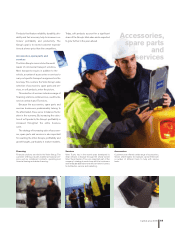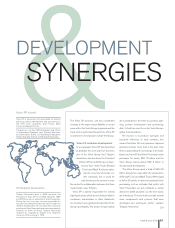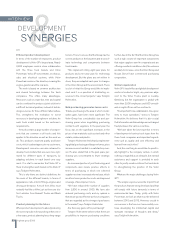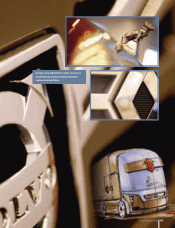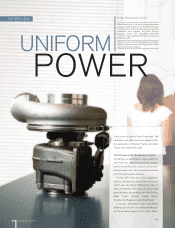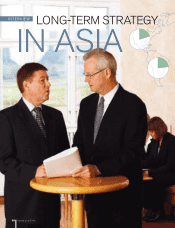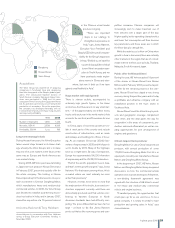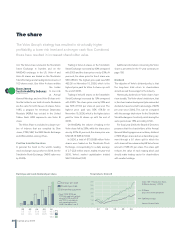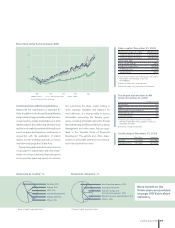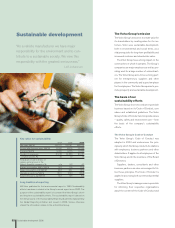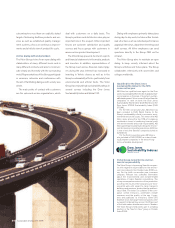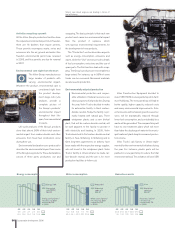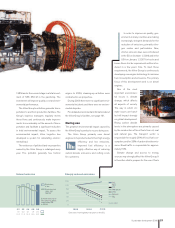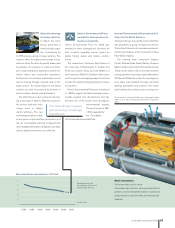Volvo 2006 Annual Report Download - page 33
Download and view the complete annual report
Please find page 33 of the 2006 Volvo annual report below. You can navigate through the pages in the report by either clicking on the pages listed below, or by using the keyword search tool below to find specific information within the annual report.
Nissan Diesel
Volvo Group
Dongfeng
Acquisitions
The Volvo Group has experience of acquiring
companies in Southeast Asia and developing
them into strong parts of the Group’s global organi-
zation. The construction-machine division of
South Korean company Samsung Heavy Indu–
stries was purchased in 1998 and its name
changed to Volvo Construction Equipment Korea
Ltd. Its operations are mostly concerned with the
production of excavators. Since the acquisition,
the company has developed favorably, with an
increased rate of product renewal, rising volumes
and improved profitability.
1998 2006
Number of employees 1,565 1,443
Net sales, SEK M 2,028 9,395
Profitability, SEK M Loss 765
Long-term strategy in Asia
During the past few years, the Volvo Group has
taken several steps forward in its Asian strat-
egy, whereby the Volvo Group’s aim is to make
Asia one of its core markets in the future, in the
same way as Europe and North America are
core markets today.
During 2006, AB Volvo purchased a holding
in Japanese truck producer Nissan Diesel and
in February 2007, presented a public offer for
the whole company. The holding in Nissan
Diesel opened up for the discussions on a pos-
sible investment in Chinese Dongfeng Motor,
which manufactures heavy and medium-duty
commercial vehicles. In 2006, the Volvo Group
also decided to establish a partnership to pro-
duce bus bodies in India, and in January 2007,
closed the acquisition of a 70-percent interest
petition increases, Chinese companies will
increasingly wish to make maximum use of
their vehicles over a larger part of the day.
Higher quality, better operating characteristics
and lower fuel consumption will then become
key parameters, and these areas are in which
the Volvo Group’s strength lies.
While the main focus is often on China when
growth in Asia is discussed, there are naturally
other markets in the region that are of consid-
erable interest to Volvo, such as India, Thailand,
Malaysia, South Korea and Japan.
Public offer for Nissan Diesel
During the year, AB Volvo acquired 19 percent
of the shares in Nissan Diesel from Nissan
Motors and in February 20 07, presented a pub-
lic offer for the remaining shares in the com-
pany. Nissan Diesel has staged a very strong
recovery during the past few years and is today
a profitable and attractive company with an
established position in the truck sector in
Southeast Asia.
Nissan Diesel’s and the Volvo Group’s prod-
ucts and geographic coverage complement
each other, and the deal paves the way for
cooperation in the areas of components, pro-
duction, sales and aftermarket, as well as cre-
ating opportunities for joint development of
engines and gearboxes.
China’s largest truck producer
Dongfeng Motor Co Ltd. is China’s largest t ruck
producer, with annual production of some
170,000 trucks. Dongfeng Motor Co Ltd. is in
equal parts owned by car manufacturer Nissan
Motors and Dongfeng Motor Group.
In the beginning of 2007, AB Volvo, Nissan
Motors and Dongfeng Motor Group deepened
discussions on how the commercial-vehicle
operations best can be developed. At that time,
a non-binding framework agreement was
signed with the intention of AB Volvo to invest
in the heavy and medium-duty commercial
vehicle and engine business.
“If handled properly, the opportunities that
could open up for us are enormous. To be a
global company, it is simply essential to have
production and growing sales in Asia,” says
Jorma Halonen.
in the Chinese wheel loader
producer Lingong.
“These are important
steps in our strategy to
strengthen our presence in
Asia,” says Jorma Halonen,
Executive Vice President and
Deputy CEO with specific respon-
sibility for the Group’s expansion
in Asia. “Behind us, we have the
successful a c quisition of w h at
is now Volvo’s excavator oper-
ation in South Korea, and we
have previously made explor-
atory moves in China and else-
where, but now it feels as if we have
gained a real foothold in Asia.”
Huge market with rapid growth
There is intense activity, accompanied by
extremely high growth figures, in the Asian
economies. And these are in no way small mar-
kets – of the approximately one million heavy
trucks sold each year in the world market, Asia
accounts for one third, and China alone for one
fourth.
In China, signs of economic growth are vis-
ible in most parts of the country and include
construction of infrastructure, such as roads
and railways, and buildings for offices or hous-
ing. As an example, China had 35,000 kilo-
meters of expressway in 2006 and this figure is
set to double by 2010. Many of the highways
have six or eight lanes. By way of comparison,
Europe has approximately 54,000 kilometers
of expressway and the US 85,000 kilometers.
“Half of the world’s population lives in Asia,
and that’s where growth is largest,” says Jorma
Halonen. “For that reason, among others, this is
a market where we must naturally be more
active than previously.”
However, it needs to be borne in mind that
the major portion of the trucks, buses and con-
struction equipment currently sold there are
domestically produced, and that vehicles con-
forming to Western European or North
American standards have had difficulty com-
peting. The price differential has been far too
large – at least so far. But Jorma Halonen
points out that as the economy grows and com-
Jorma Halonen & Tony Helsham
Jorma Halonen in conversation with Tony Helsham
during a Group Executive Committee meeting in
November 2006. A global group 2006 29


